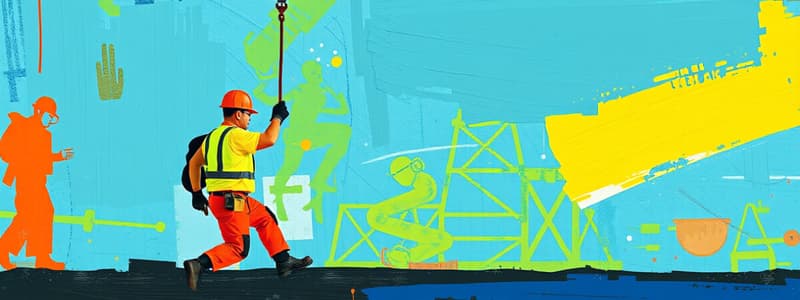Podcast
Questions and Answers
What should you do if manual handling cannot be avoided?
What should you do if manual handling cannot be avoided?
- Ask someone else to do it
- Use the correct manual handling technique (correct)
- Avoid using any lifting equipment
- Lift items with your back
It is acceptable to cross safety barriers if you are authorized.
It is acceptable to cross safety barriers if you are authorized.
True (A)
What should you maintain while driving a vehicle?
What should you maintain while driving a vehicle?
Always wear a seat belt.
What is the minimum height for a fall risk during work?
What is the minimum height for a fall risk during work?
Which of the following should you check before using a ladder?
Which of the following should you check before using a ladder?
What is the consequence of horseplay at work locations?
What is the consequence of horseplay at work locations?
All workers should have training for high-altitude work.
All workers should have training for high-altitude work.
Match the safety equipment with their purposes:
Match the safety equipment with their purposes:
Workers must maintain _____ awareness of their surroundings.
Workers must maintain _____ awareness of their surroundings.
What should be done if tools cannot be hand-carried?
What should be done if tools cannot be hand-carried?
What is the required number of personnel in a high-altitude rescue team?
What is the required number of personnel in a high-altitude rescue team?
Flashcards are hidden until you start studying
Study Notes
Work at Heights and Fall Prevention Training
- Adhere to procedures, obtain work permits, and conduct risk assessments to ensure safety.
- Minimize manual handling; if necessary, use proper lifting techniques.
- Always comply with safety signs and warnings; never breach safety barriers or enter restricted areas without authorization.
- Wear and maintain appropriate personal protective equipment (PPE).
- Always fasten seatbelts while driving; avoid using mobile devices, including hands-free kits, while operating vehicles.
- Maintain clean and clutter-free work environments; use handrails when navigating stairs.
- Ensure tools are suitable for tasks and well-maintained; prohibited horseplay or activities at work sites.
High Altitude Operations
- Operations performed at a height of 2 meters or more pose a risk of falling.
- Typical high-altitude jobs include using ladders, scaffolding, and other elevated work platforms.
- Annual death toll from falls exceeds 11,000, with over 200,000 cases of permanent disability.
Personnel Requirements for High Altitude Work
- Workers must be physically fit without conditions like acrophobia, hypertension, or heart disease.
- All personnel must undergo relevant training and acquire necessary skills for working at heights.
Fall Protection Devices
- Fall protection equipment includes full-body harnesses, safety nets, and lifelines.
- Always inspect fall protection gear before use; report any issues immediately.
- Select sturdy anchor points for safety gear, capable of withstanding at least 2250 kg; avoid using cable trays and guardrails as anchor points.
- Follow the "high and tight" principle when using safety harnesses.
Work Control Measures
- Work permits must be verified by area supervisors and task executors prior to starting work.
- Rescue equipment should always be on-site and checked against inventory lists before work commences.
- High-altitude work is prohibited during severe weather such as strong winds (over 15 m/s), thunderstorms, heavy rain, snow, or fog.
- Clear ice, snow, and oil from work areas, implementing effective anti-slip measures.
- Sufficient lighting is required for nighttime operations.
Object Fall Prevention
- Establish exclusion zones and safety signs below high-altitude work areas to protect personnel below.
- Release pressure or secure equipment in areas below where work may pose a risk.
- Store tools and materials securely; never carry excessive weight; utilize hoisting tools for transport.
- Avoid stacking materials on scaffolding; secure all tools and materials when work is paused.
High Altitude Work Requirements
- Conduct job safety analysis (JSA) meetings before starting high-altitude work.
- Develop a high-altitude rescue plan and ensure all workers are familiar with its provisions.
- Secure a “cold work permit” before engaging in high-altitude activities.
- All participating personnel must undergo relevant training to understand associated risks.
- Rescuers should be trained and aware of their responsibilities.
Rescue Requirements for High Altitude Work
- Identify and publicize a list of personnel trained in high-altitude rescue within each unit.
- Each rescue team must consist of at least three individuals (one team leader and two members).
- In case of a fall incident, the rescue team must execute the high-altitude rescue plan immediately.
Studying That Suits You
Use AI to generate personalized quizzes and flashcards to suit your learning preferences.




